
MARCH OF THE TITANS - A HISTORY OF THE WHITE RACE
CHAPTER 3 : THE NEOLITHIC AGE
As the climate improved with the recession of the last great ice age, Late Paleolithic man gradually became more settled and started staying in favorable spots for longer than previously.
These first fixed settlements led to a shift from a food gathering society to a food cultivating society, and the appearance of crops and the domestication of animals become features of their way of life. This change in culture is called the Neolithic Age.
A regular and continuous food supply created by the establishment of farming meant that bigger populations could live in settled, more secure, areas, and this marked the first time that the luxury of non-food producing professions within society became possible.
This shift from hunter gatherer to settled agriculturalism occurred in fits and starts all over White occupied Europe and the Near East.

A Neolithic era axe
The earliest farming sites in northern Europe are to be found in Ireland, occurring at approximately the same time as the cultivation of crops in the Mesopotamian River valley in the Near East. As a general rule, the first Neolithic settlements can be said to have been established around 10,000 BC, and the cultivation of edible plants and the domestication of animals was commonplace all over Europe, the Near and Middle East by 5000 BC.
EUROPE AND THE MIDDLE EAST - EQUALLY ADVANCED
The existence of an original civilization on the continent of Europe which predates the civilizations in the Middle East, has to a large degree been ignored by traditional history writers, particularly those who wrote during the dominant Christian era in Europe.
This was largely because of a biblical Judeo-Christian bias which held that all civilization started in the Near East (the biblical Old Testament deals exclusively with events in the Middle East, and conventional wisdom during the Age of the Church held that the Garden of Eden was in the Middle East).
This is not an accurate reflection of the facts, as in many parts of Europe relatively advanced societies were in existence either before or simultaneously with the Mesopotamian or Egyptian civilizations.
While it is most certainly true that the great cities and states in the near and Middle East were towering achievements, it is incorrect to regard them as the only flowering of civilization in the world at that time.
There are many huge buildings - called megaliths - and early Neolithic settlements, artifacts and burial sites and even the creation of a form of writing, which show that the inhabitants of Europe were advanced in the evolution of their societies and culture.
This Old European civilization lasted for approximately 3000 years, and then fell before waves of new invaders, the Indo-European or Nordic tribes sweeping in from the area we now know as Russia.
SAME RACE AS IN ORIGINAL MIDDLE EAST
This is not to say that the original Old European inhabitants - mainly Mediterranean racial types with a minority of Proto-Nordics - were of a different race to those inhabitants of the Middle and Near East at that time.
Indeed, the first civilizations in the Mesopotamian River Valley (in present day Iraq) were also created by White Mediterranean and Proto-Nordic racial types, as can be seen by the large number of surviving artifacts and images dating from this period in early White history.
EUROPEAN CONTINENT
Cereal grain farms were established in central Europe by 8000 BC (almost simultaneous with the Mesopotamian "fertile crescent" river valley crop cultivation) with some of the best preserved farming settlements in France and Britain have been positively dated as being in existence prior to 4000 BC.
Significantly, copper working had been established in the Balkans by the year 5000 BC - some 2000 years before the first civilization in the Mesopotamian river valley.
In Neolithic Europe, where wood was abundant, rectangular timber houses were constructed. Some had two rooms and even gabled roofs. Remains found in Switzerland dating from around 5000 BC show that even on soft, swampy ground, the builders were able to erect houses by first laying down wooden foundations or on piles going deep into the ground.
By the year 5000 BC, White Neolithic settlements had taken on the form of established villages, towns and in a few cases, even cities, scattered throughout Europe, western and southern Russia.
These early Neolithic farmers cultivated cereals, and kept domesticated animals such as pigs, cattle and dogs. Farms were established across the European continent, with some of the best preserved sites being found in Ireland.
Their tools and hunting weapons were mostly made of flint, and their houses of timber. Clothes were made of leather, and there is also evidence of weaving. Other small implements were made of antler and bone, and they have left many examples of fairly sophisticated pottery.
BURIAL MOUNDS
The leaders of this early White society were buried according to religious rituals which are now unfortunately lost - but the physical graves are a good source of knowledge about their society as a whole. Important leaders were buried in specially constructed narrow mounds called barrows. The existence of these grave sites - and a number of chance discoveries of less important graves - have served as valuable indicators of the racial make-up of these early Europeans.
The general rule is that the further north, the more dominant Nordic or Proto-Nordic, while in places like Britain and central Europe, there were a significant number of Alpine and Mediterranean racial types.
WRITING - 4000 BC
These original continental European inhabitants had also developed a form of writing - called Old European linear script - around the year 4000 BC. The exact origins of this language are lost (there is evidence that some or all of it may have come from Indo-European or Nordic invaders who penetrated Europe from their bases in Southern Russia around this time).
This language most likely laid the basis for sharp angular writing known as runes.

Undeciphered writing on the Tartaria tablet, found in Tartaria, Rumania, and dated at 4500 BC - this competes with the Azilian script for the claim to the oldest writing on earth.
FIRED POTTERY AND GOLD WORKING
Hand fired pottery was produced in the Balkans around 6500 BC. Cities of more than 1000 inhabitants - huge by the standards of the time - had been established approximately by the year 5000 BC.
There are copper mine shafts - some 20 meters deep - still existing in the Balkans which date from before the year 4000 BC.
Gold worked jewelry discovered in the Balkans predates the gold working skills of the Egyptians by at least 1600 years. By the year 2500 BC, copper working had spread all over continental Europe, with archaeological evidence being found of extensive trade between settlements in England, France, Holland and into central Europe .
IRON WORKING
The introduction of iron working into Western and Northern Europe - around the year 1000 BC - from central Europe and the Near East - ushered in a new era, and it is from approximately this time that the early West Europeans started building hill top forts, which later evolved into castles. These hill top forts are scattered all over Europe, and some remained in use as forts right until the time of early Christianity, some 1600 years later.
MEGALITHS
In many parts of Europe, the longest lasting remnants of this era are the megaliths ("large stones") which may have had some religious or recreational purpose. Massive blocks of stone, and sometimes wood, were moved great distances and erected in chosen areas throughout Europe, from Britain right across the continent, some even as far as the Black Sea - in Southern Russia - a stupendous achievement.
The most famous of these megalith sites is Stonehenge in Wiltshire, England, which was built in stages, the first part being erected between 3500 BC and 3000 BC.

Stonehenge, England, circa 3500 - 1500 BC. Neolithic Period.
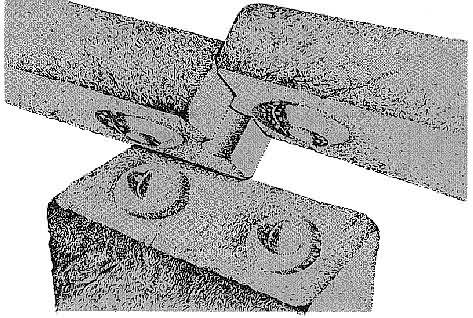
The stones used at Stonehenge were cut on site and used an ingenious ball and joint system to lock into place, as illustrated above. The ball can still be clearly seen on the top of the upright stone below. The White people who built Megalith monuments such as these were no intellectual or technical barbarians, proving wrong the often malicious propaganda portraying the inhabitants of early Europe as savage barbarians who lived in caves.
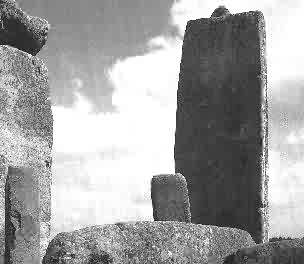


Above: Building Megaliths was no easy task. The effort required to pull one of the massive stones erect was in itself a marathon effort, and then raising the equally huge lintels onto the top of other stones required a great deal of planning and foresight. Exactly how the early Whites did it is still a puzzle to archeology. These illustrations of how the stones were raised and of how a lintel was placed are the most commonly accepted theories of how these superhuman feats were achieved thousands of years ago.
To put this in perspective: the first stage of Stonehenge was built about 1000 years before the great Egyptian pyramids were built. (The last part of Stonehenge was built around the year 1000 BC - hundreds of years before even the Greek and Roman civilizations.) Neolithic farmers in Europe created a number of other impressive structures predating even Stonehenge.
One of the earliest is situated quite close to Stonehenge, called (confusingly) Robin Hood's Ball, which consists of what appear to be circular foundations for either a large hall or number of buildings and a grave site (judging by the human remains found in surrounding ditches). This structure dates from the very early Neolithic time, around 4000 BC, and indicates the establishment of set social structures at this early stage of European history.
Often overlooked as historical evidence for the technological ability of the Neolithic settlements are the burial chambers and tombs which are scattered over large parts of Europe: some of the oldest megalithic chamber tombs had been radio carbon dated at 6000 BC - some 3,500 years older than the famous Egyptian pyramids.

Megalith temple, Malta, circa 3000 BC. Neolithic period.

Megalith tomb walls, intricately carved, dating from before 3000 BC, Brittany, France.

Neolithic Hall, Bories, near Gordes in France.
There are four types of megaliths: the menhir, or monolith, a single standing stone often of great size; a set of menhirs set in a circle, as at Stonehenge in England; a row of menhirs such as those to be found at Carnac in France; and the burial chamber, or chamber tomb, sometimes called a dolmen.
The chamber tombs are the most common type of megalith : more than 50,000 examples have been found on the European continent. Some of these tombs' interiors were decorated with intricate stone carvings and geometrical patterns, making stunning viewing even thousands of years after they were created.
| The "Lux et Orient" or "All light comes from the East" dogma which Christianity introduced, held that all progress and civilization came from the Middle East. With accurate dating methods and intensified archeological research, it has now been shown that advanced civilizations flourished in Europe, sometimes thousands of years before similar technological advances were made in the Middle East. |
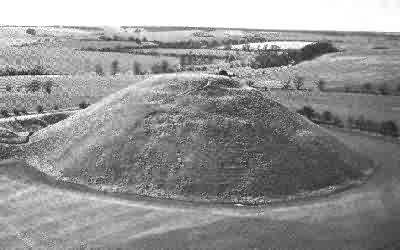
One of the oldest pyramids in the world is to be found near the present day town of Marlborough, in Wiltshire, Britain. Called Silbury Hill, it is the largest prehistoric mound anywhere in Europe, standing nearly 40 meters high. It dates from around 2660 BC, preceding the great pyramids of Egypt. Although today covered with soil, excavations have revealed a carefully constructed step pyramid under the silt (as shown in the illustration below).The exact purpose of the pyramid is unknown, but it forms part of the great Avebury stone ring complex, which includes a stone circle larger than Stonehenge and a series of barrow tombs. The enormity of the building stands as a monument to the intellectual abilities of the Whites of early Britain. These were no uncivilized barbarians who erected these technically sophisticated structures.
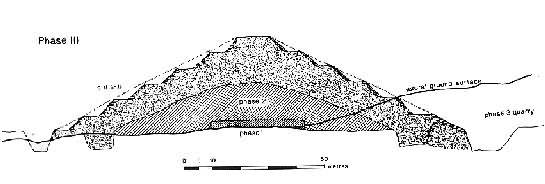
WORLD'S OLDEST CITIES - 7000 BC
The growth of Neolithic settlements in Europe were matched by the growth of similar settlements in the Middle and Near East, with once again the majority of the population being Mediterranean racial types with a not insignificant number of Proto-Nordics accompanying them, very often as tribal leaders (a tradition which was most pronounced in Egypt).
By 7000 BC a town of mud brick houses and town walls had been built by Mediterraneans at the site now known as Jericho in Palestine. In Anatolia, Turkey, remains of another major city, Catal Huyuk, have been excavated, dating from approximately 6200 BC. This city also possessed brick making facilities, as well as the already established cereal crop cultivations.
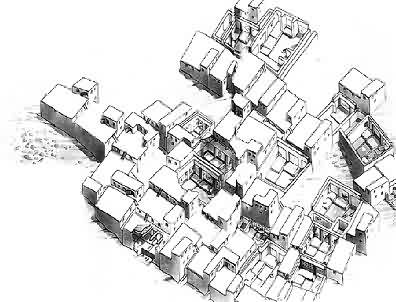
Above: A reconstruction of the first city in the world, Catal Huyuk, Anatolia, present day Turkey. This city flourished from about 6250 BC to 5400 BC, and was excavated in part in 1961. The photo below left, shows the rectangular shape of the buildings: as there is no readily available stone to build defensive walls, the buildings were made to face inwards, with no windows on the outside. The only entrance to the city was through ladders leading onto the roofs of the outside buildings. The streetless city offered a high degree of protection from outside attackers in this way - if under attack, the outside ladders were withdrawn, and any would be attacker was faced with a solid wall and no gate or other weak point. This city marked a revolution in Neolithic settlements. The people of Catal Huyuk were most likely farmers and cattle herders who needed to live closely to the broad plain stretching to the north of the city. Hence the shrine discovered in the city, below left, which appears to be linked to some sort of Bull cult.
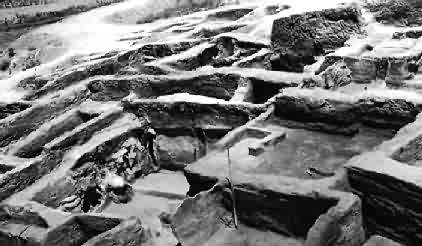
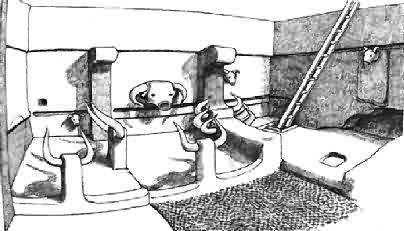
All over the near East around the year 5000 BC farming villages were established upon which the non food producing professions could be built. At this time pottery made its appearance in large quantities throughout the areas of Neolithic settlement. In the Middle and Near East, these racial types were eventually displaced and intermingled with massive waves of Semitic, Arabic, along with imported Negroid slaves and eventually even Mongoloid invaders. It is from this mixture that the modern Egyptian and many other North Africans are descended.
OLD EUROPEAN
With the creation of fixed settlements and continuous, albeit slow, technological advances, it became inevitable that these communities would take their next great step: the establishment of a system of literacy and a formal social contract between the individuals making up communities - the creation of laws and formal ways of interaction.
The creation of fixed settlements in Europe and the Near East as a result of the farming revolution known as the Neolithic age laid the basis for the next great leap in White civilization: the establishment of Old European civilizations in central Europe and in the Near East.
or
All material (c) copyright Ostara Publications, 1999.
Re-use for commercial purposes strictly forbidden.